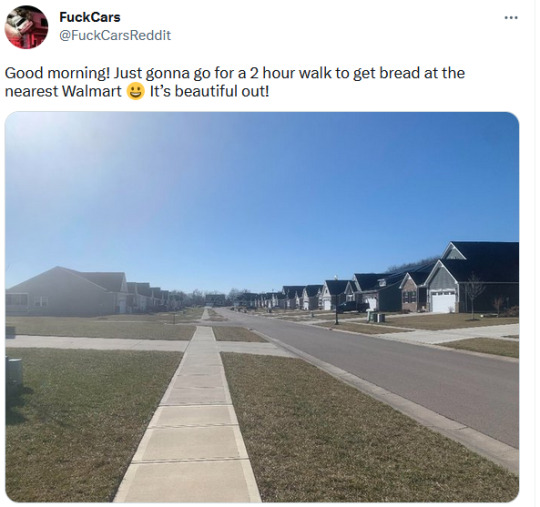Text
there is a massive difference between being punk because you believe in the message and being punk because you want an excuse to be rude and angry.
don’t get me wrong, anger is a completely rational response to being attacked. i would argue almost everyone is under attack right now. but do you wear those patches because you want to make a change in the world? do you care about people? do you care that others you might not agree with have rights?
because if you are going into the punk scene with a rage against everyone, you are going to warp the movement.
caring and being kind is an active choice you have to make everyday. it is not easy. it is incredibly difficult and it would be so easy for me to give that up and say “fuck the world because it left me behind” but that will not change anything. it will not make people want to be around me, it will not make them care.
sad to say it, but you have to engage with things critically. you cannot act solely on emotion when trying to make meaningful change. look at your own motivations and ask yourself do i want to help people or do i just want an excuse to hurt people i deem “bad” or less than myself?
if your response is to hurt others in the name of change you’ve already fucked up.
854 notes
·
View notes
Note
Can you give me examples of praxis, mutual aid and dual power I can do? If it helps anything, I live in Southern Sweden, but I just in general have no idea where to start.
Good question!
Just to emphasise, praxis is an action that intends to facilitate the fruition of one’s political ideals, so mutual aid, the facilitation of direct democracy and the creation of dual power are all modes of praxis. It sounds like you knew this already though.
There are loads of ways to get involved! In this post I’m going to talk about three things, namely;
1: theory
2: networking (how to meet up with other anarchists!)
3: mutual aid (the most important one)
1: Theory - Reading theory is a great way to understand what you’re doing and why you’re doing it

As I’m sure people will tell you, theory is not the be all and end all of being an anarchist. You can easily get away with being an anarchist without reading a drop of theory.
But it helps. When you’re exploring anarchism and your relationship with it, you’re probably going to have a lot of questions, and people have devoted novels and novels all to just answering those questions! Here’s a big directory of resources just for you!
If you’re looking for a good introductory book, I cannot recommend enough the ABCs of Anarchism by Alexander Berkman. It’s what got me into it. I would recommend reading some introductory stuff before you explore other important anarchists (Kropotkin, Bakunin, Goldman), since the older foundational stuff can be antiquated or difficult to read in places. Kropotkin’s Mutual Aid is a great praxis guide, though.
2: Networking - Go to local meets for anarchists in your area
Forgive me if I have this wrong, but Southern Sweden is fairly urban, right? If you live in a town or city, there’s a really good chance there’s anarchist organisations or at least mutual aid groups in your area that will hold meetings to discuss topics concerning anarchism and even leftism in general. They’ll also probably do a book club; anarchists famously love books.
(Hilariously, one factor that makes it so hard for the police to infiltrate anarchist groups is that the debate is so intense and various that they stick out like a sore thumb.)
These are the groups that Wikipedia has to offer.

I really have no idea what these guys are like; I’m from a tiny little village in the UK. It’s worth looking about. Anarchists tend to put up flyers for the organisations in their local area (provided they’re not super spicy lmao).
If you go to the meetups and the organisation seems like it’s got its shit together, join up! It’s a lot easier to help your community as a mutually interested collective than it is as an individual (obviously).
3: Mutual Aid - DO! MUTUAL! AID!
Many anarchists will tell you that the single most important way to get involved as an anarchist is to do mutual aid. I concur, honestly. Mutual Aid is the foundation of anarchist society. It is the sharing of resources and the collective commitment to respecting and supporting everybody you possibly can that forms the backbone of anarchist society.
Mutual aid is a form of direct action, i.e. tackling an issue by directly focusing on the material conditions that generated the issue. It relies on individuals coming together with their wider community to co-operate in order to mutually achieve a set aim.
I say this a lot! And I’ll say it again!
Mutual aid is for everyone, no matter your situation. Everybody needs help sometimes. The point is that we build networks of trust and reliability that will eventually come to fruition in full-fledged anarchist society. Given the scale of anarchist projects in western society at this point, though, many anarchists focus on specific and pressing issues in their area.
It’s important to remember that the nature of capitalism is such that almost everybody is two or three really bad months away from poverty. Capitalism hurts everyone and mutual aid is an effort to alleviate that suffering. Mutual aid is for everyone.
Here’s some examples of common mutual aid projects, taken from this article

mutual aid is various and complex, much like anarchist society.
One mutual aid group I heard about the other day is a group that helps alleviate loneliness in the elderly by visiting their homes and helping them with their groceries, etc.
mutual aid also played an important part in the Greensboro sit-ins movement and the wider struggle for civil rights in black communities in America throughout the 1950s-70s, and remains in that key role today.
It works so well for marginalised groups because it allows disempowered individuals to pool their resources in order to make a greater impact on the issue. It logically follows that it would be a huge axis of anarchist organisation.
88 notes
·
View notes
Text
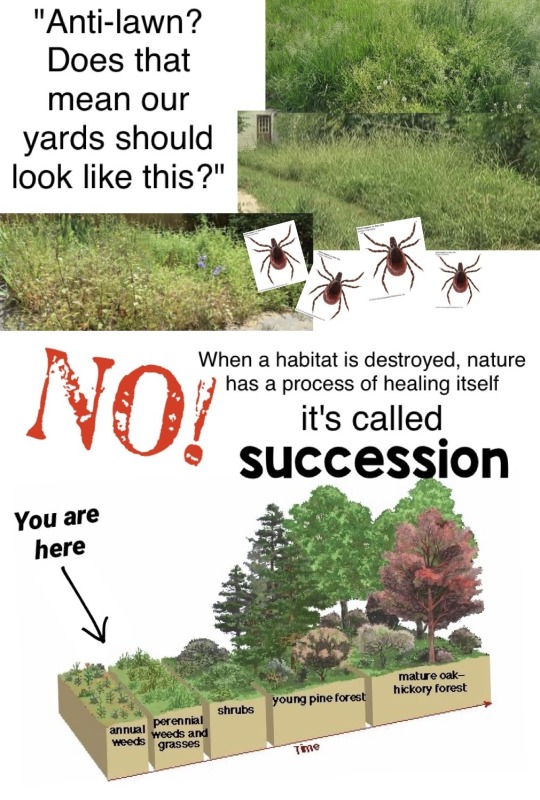
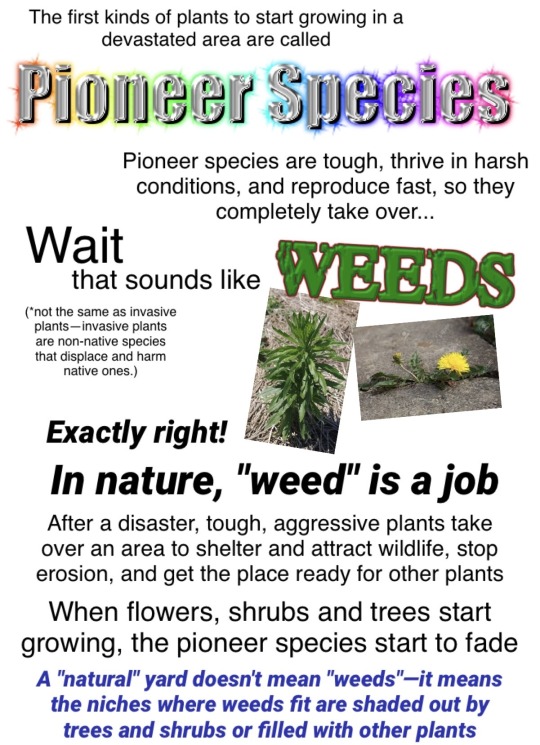
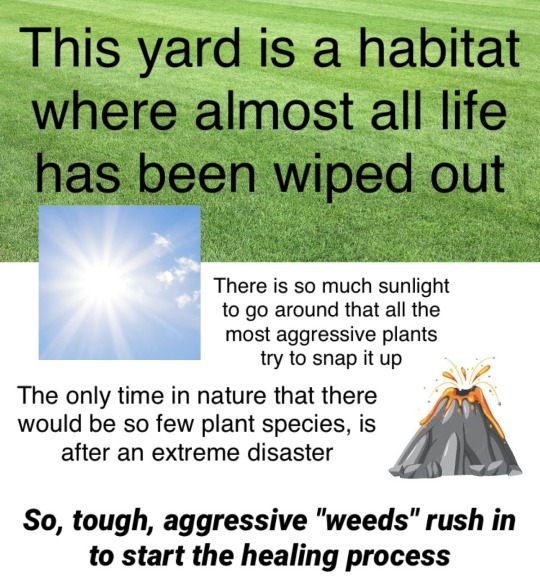
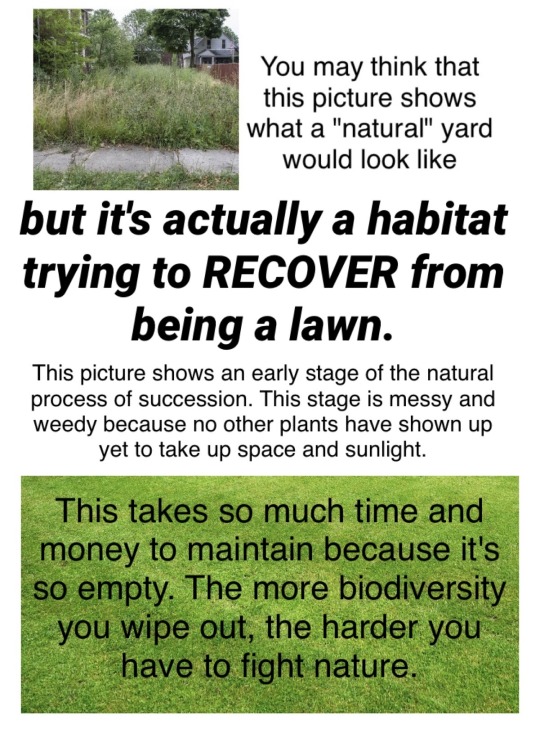

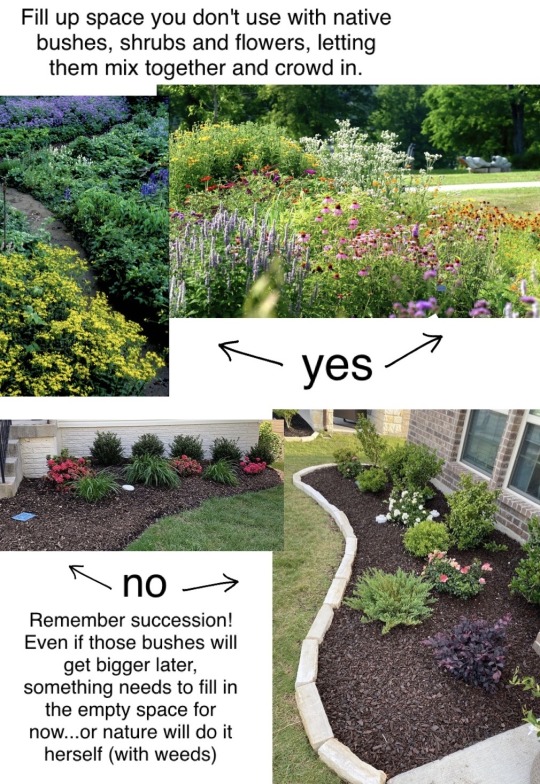
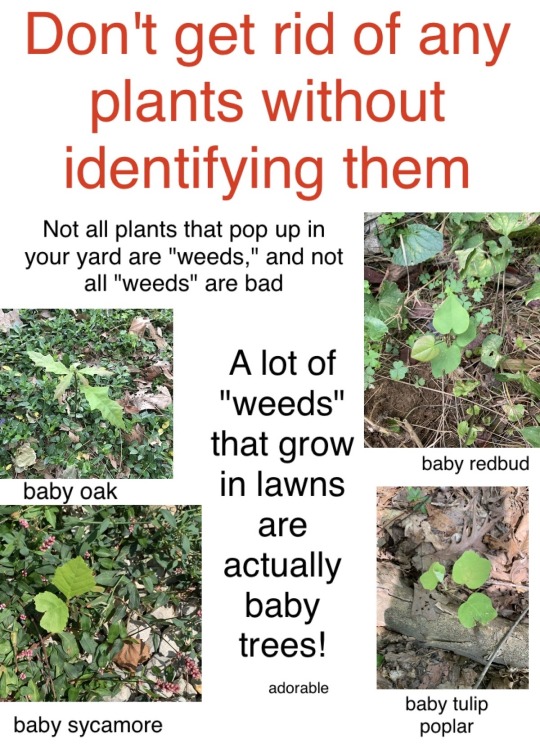
I...tried to make a meme and got carried away and made A Thing that is like partially unfinished because i spent like 3 hours on it and then got tired.
I think this is mostly scientifically accurate but truth be told, there seems to be relatively little research on succession in regards to lawns specifically (as opposed to like, pastures). I am not exaggerating how bad they are for biodiversity though—recent research has referred to them as "ecological deserts."
Feel free to repost, no need for credit
180K notes
·
View notes
Text
I wonder if work just.. got harder in the 2000s, comparatively.
88K notes
·
View notes
Text
I recently discovered laundry stripping and y’all, no matter how much of a crock of shit you think fast fashion is, you’re underestimating.
97K notes
·
View notes
Text
Wait no stop pls stop
What if we didn't make jokes and normalize microplastics like we did with our privacy & FBI/NSA agent.
What if we were actually really mad and stayed mad and screamed at these companies instead of making memes like microplastics in dirt and blood and water is funny and not horrifying.
What if instead of making them think they're just giving us new meme content and that they don't have anything to change cuz we're too apathetic about them destroying the planet... What if we talked shit and insistently called for the shutdown of every company who isn't investing in minimizing plastic use or plastic products. What if we refused to normalize and make light of it.
What if we made them realize Exactly how serious it is and that we aren't just gonna lie down and take it this time.
We don't need it. Not everything used to be in plastic.
Pls do not make this another thing that only activists are trying to stop. Don't make this another thing everyone just accepts so correcting it becomes an uphill battle.
Don't fucking do that to all of us, please.
Don't just accept this.
5K notes
·
View notes
Text
Why do my interests in canning, couponing, and homesteading overlap so often with blogs with titles like ‘The Obedient Housewife’?
#homesteading#solarpunk#useful#self sufficient living#self reliance#resources#gardening#self sufficiency#hopepunk#diy#diy punk#educational
145K notes
·
View notes
Text
A lot of people don't know about why lawns are so disliked outside of how they are a waste of water, so here:
carbon emissions put out by lawn mowers (and other devices like leaf blowers). Lawn mowers produce significantly more greenhouse gases per hour of use than cars, and majorly contribute to smog.
Fertilizers get into bodies of water and cause algae blooms, converting all the diverse water plants to homogenous green slime.
Pesticides kill fireflies, bees, and all sorts of other beneficial insects, and many can kill or harm fish, birds and even humans.
Herbicides can have negative effects on the wrong targets too, but they are also causing common agricultural weeds to evolve resistance faster, increasing our dependence on pesticides.
Watering lawns does waste a lot of fresh water.
Lawns replace areas that once could have contained 100+ plant species with monocultures of frequently invasive species. Butterflies can't find host plants this way. Bees can't find food. Thousands of insect species rely on specific plants for food, and no other plant will do. A huge amount of the land is taken up by these wastelands.
Lawns also create dead, compacted, lifeless soil that is hard to grow other things in or near. The root systems of turf grasses are not robust enough to allow water to penetrate in. No matter how much nitrogen and phosphorous you dump on a lawn, it will still be lacking in the organic matter needed to create lush, absorbent dirt.
Dirt is supposed to be full of fungal mycelium. Scientists have discovered recently that the vast majority of all plant species are dependent on a network of symbiotic fungi attached to their roots for 80% of their phosphorous needs and 90% of their nitrogen needs.
Yes, this means that when you put a fungicide on your lawn, you've just nerfed that plant's ability to absorb nutrients by up to 90%. And you've also devastated its ability to absorb water, because plants are partly dependent on their fungi to get water out of dirt.
But fungicide isn't the only problem. Every plant in a natural environment is attached to multiple species of fungus, and most fungi are attached to multiple species of plant (though some are specialists). Trees literally use this system to send nutrients to other trees. We discovered recently that trees in deserts in California can survive extreme drought because they're attached to fungi that can break down rocks and extract water from the rocks.
If you don't have a good variety of plant species and rotting leaves and sticks and stuff, it doesn't matter how much fertilizer you put on it, your soil isn't "healthy" because it's not alive.
Vegetation that has been cropped extremely short doesn't hold in water, so a heavily maintained lawn is likely unnaturally dry for your climate, and a flower or bush in the middle of a lawn without tall grasses, shrubs and weeds nearby is getting pounded by the sun much harder than it's meant to handle.
Yeah, gardening isn't hard, most native plants are falling all over themselves to grow, it's just that the standard suburban backyard is ridiculously hostile to life.
Of course at this point you may be wondering
"What do I do instead?"
Well, here you go:
Stop weeding, spraying and fertilizing. Seriously. Stop it!! Stop it!! Chemical intervention in your lawn traps you in a vicious cycle of creating problems that need to be solved with more chemicals.
"Weeds" are a perfect example. Plants commonly considered "weeds" are adapted to take over areas that have been cleared out of other plants. Many "weeds" are actively harmed by the fungi that other plants depend on, meaning they can ONLY thrive in disturbed or devastated areas. The harder you work to eliminate biodiversity in your yard, the harder nature is going to bomb your yard with weeds.
By the way, google the "soil seed bank." Seeds can stay dormant in soil for years or even decades. If you want a "weed-free" lawn, get ready to apply herbicides for the rest of your life.
Mow less often. You really can't go wrong with this one.
Don't try to grow grass where grass doesn't want to grow. Lots of shade? Try moss. Extremely dry? Try drought-adapted plants. See what wants to grow there and let it do its thing.
It's fine to have a lawn area that you actually use. But if no one walks or plays on a stretch of your lawn, it should be something else. A wildflower patch, a stand of prairie grasses, some large shrubs, a grove of trees.
By the way, the idea that shrubs or flower beds are higher maintenance than lawns is wrong. The neat thing about native species is that once they've gotten settled, you literally just do nothing.
People think flower beds are high maintenance because people almost always underpopulate them. They think that there should be big spaces of mulch in between each plant. In a full sun flower bed that's actually filled to capacity, you shouldn't be able to see the ground. If your plants aren't babies anymore and there's still space, more plants.
if you live in an area that was once forest, PLEASE, plant some trees, and not just one tree. Trees are somewhat like guinea pigs, actually, they don't want to be alone. They send each other nutrients through their roots and screen each other from wind damage.
By the way, the "mature spread" of a tree as told on websites means when you plant it by itself. Trees can generally be planted 6-10 feet apart and be perfectly happy, they'll just grow taller and straighter instead of spreading out. (Look at pictures of forests.) HOWEVER large trees like large oaks should really be 25+ feet from structures and septic tanks
(Trees pop up by themselves in lawns. Constantly. Search for them in a woodland biome and you will likely find baby oaks and maples and other cool guys.)
Trees introduce competition for light into the areas you plant them, helping eliminate the "weeds." You know how fast your lawn grows up and gets weedy when you don't mow it? Yeah, that's partly because it's getting a CRAP TON of sunlight dumped on it with reckless abandon.
A shade garden gets "weedy" WAY slower, and unlocks all sorts of gorgeous flowers that don't thrive in a full sun garden. Fallen leaves serve both as compost and mulch. If you live in the right area for it and have room, you cannot go wrong with trees.
6K notes
·
View notes
Text
*taps the glass* hey, y'all know that what you might want isn't necessarily what's best to legislate?
55K notes
·
View notes
Note
Do your followers know about Libby? It's an app where, at least in the United States, you can listen to as many professionally recorded audio books as you'd like for FREE, so long as you have a library card. You don't even need to visit the library, you can just borrow the audiobooks from your phone.
I don't know. I hope they do. But perhaps a few more of them will after reading this.
8K notes
·
View notes
Text
Ways to Live in Direct Opposition to Capitalism
I am by no means an expert in any of these things I’m gonna talk about, so keep that in mind! I am just making a compilation of things I know of that we can do to lessen the stranglehold the capitalist lifestyle has on us while enriching our lives, our surroundings, and the lives of others. Please add anything I miss or correct anything I may be getting wrong! Anyway here goes!
Use what you have, fix what’s you can, make what you can, accept from others, thrift what you can, and finally purchase as a last resort.
This is advice I have seen float around here a couple of times that can apply to a lot of things including clothing, furniture, food, and more besides. It’s meant to be done roughly in that order as it applies to what you’re wanting/needing/doing. It’s about preventing waste, promoting self-capability, having a heightened reliance on your community, and consciously rejecting the ingrained habit many of us have to just purchase things or services.
Here’s where you can read about growing an indoor garden!
Here’s where you can read about sewing things yourself!
Here’s an online site for giving and receiving items for free!
Here is where you can find a local Mutual Aid to get things from, learn skills from, give do, volunteer for, etc. (in the U.S.)
Be politically active! (from a U.S. perspective)
Vote for every election. Know your representatives and those who will be competing in the next election. Vote without ignorance and without falling for unfounded claims. While operating within the system that actively oppresses us will not bring about the future we want, it can serve as damage control (preventing worse candidates from taking office) and it can potentially create a national atmosphere more open to change.
Here’s a good article about getting more involved in the U.S. political process.
Here’s a site that will show you how to register to vote, when and where elections are held, and more!
Here’s good advice on finding protests in your city!
Here’s some readings on unionizing! It’s your legal right to unionize!
Here’s a more user friendly site for learning about unions!
Be active within your community!
Developing strong, motivated, capable, knowledgeable, and inclusive communities is the ultimate way to combat the relentless and bleak present and future. When you’ve worked on the things above and have gotten good at it (or even if you haven’t gotten good at it yet), start spreading what you know and what you can do with others!
Give your neighbors, coworkers, and friends some of the vegetables you’ve grown.
Invite your community members to volunteer events.
Talk to folks about how to vote, when you’re doing it, etc.
Take part in Mutual Aids to teach what you’ve learned or whatever you may be an expert in! Invite neighbors, friends, and coworkers when you take part in the Mutual Aid!
Accept your community. Take them for who and what they are. Discrimination is the enemy of cooperation. You have much more in common with everyone in your community than a single billionaire or corporation. We’re all passengers on this spaceship earth.
Do it one step at a time!
Obviously we can’t do all of these things at once. Do what you can when you can, and you’ll start to notice real change in your life!
Our online communities where we talk about our visions and hopes are fantastic, but they have little impact if we don’t actually get up and do the real work that change requires.
Want to be better, and keep hope for the future!
Harbor and nourish that desire to be a better person and to be the change you want to see in the world. You need to be hungry for a better future if you plan to make it through the rough times when everything feels pointless and without hope. Reach out to others when you’re down, and be someone others can lean on when their lives get hard.
That’s it! Please interact with this, spread it to others, and add your own thoughts and ideas! It’s important that we do the real work to get the change we crave!
#solarpunk#punk#hopepunk#anti capitalism#anti consumerism#anti consumption#tumblr#/r/196#r/196#196#community#socialism#communism#lgbtq community#gay pride#blacklivesmatter#do the work#positive vibe#positivity#learning#tips#tips and tricks#activism#change#teamwork#revolution#Make a comment! Start a discussion! Add your thoughts!
6K notes
·
View notes
Text
I really want to talk about how important it is for us as a people to start making proper city design a priority. I also want to talk about how the privatization of land is the first major barrier to having proper city design.
A lot of seemingly complex issues and tasks can be simplified or made easier to deal with by organizing our cities: Food distribution, commute times, housing, neighborhood safety, public transportation, business/practice regulation, emergency preparedness, general accessibility, mental health, access to medical services, public health, and probably a ton of other things I can't think of right now.
All of that and more could be made much easier if we organized our cities with things like mixed-use-development, the standardization of public transport over personal vehicles, a grid structure, prioritizing walkability on surfaces safe for the disabled (sidewalks over cobblestone), designating districts for certain kinds of services, mandating better minimum (and maximum) size requirements for homes, requiring a certain percentage of greenery or some form of nature for every square footage, and other tactics that I'm probably not even aware of since I'm no city planner.
All of this gets shit on when land can be privately owned, though. Businesses, rich folks, the greedy, and the ignorant buy land without any planning in mind for their community which leads to disorganized, unoptimized, and community-unfriendly cities/towns. Our efforts should always generally lead to the betterment of our community over the selfish betterment of our private circumstances.
#amazing ideas!#thanks for interacting!#this is such a complicated topic with a lot of depth. i feel like we could talk this over forever and I'd love to!
279 notes
·
View notes
Text
Not to sound like a terrifying communist or anything, but I think it's bad when we let people die from preventable causes.
7K notes
·
View notes
Text
Had a few folks interested in how I made the patches I posted for Solarpunk Aesthetic Week, so I thought I'd give y'all my step-by-step process for making hand-embroidered patches!
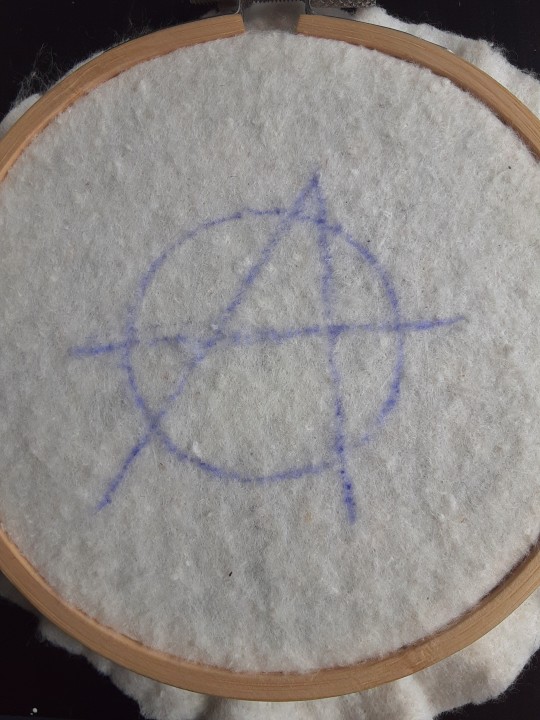
First, choose your fabric and draw on your design. You can use basically any fabric for this - for this project I'm using some felt I've had lying around in my stash for ages.
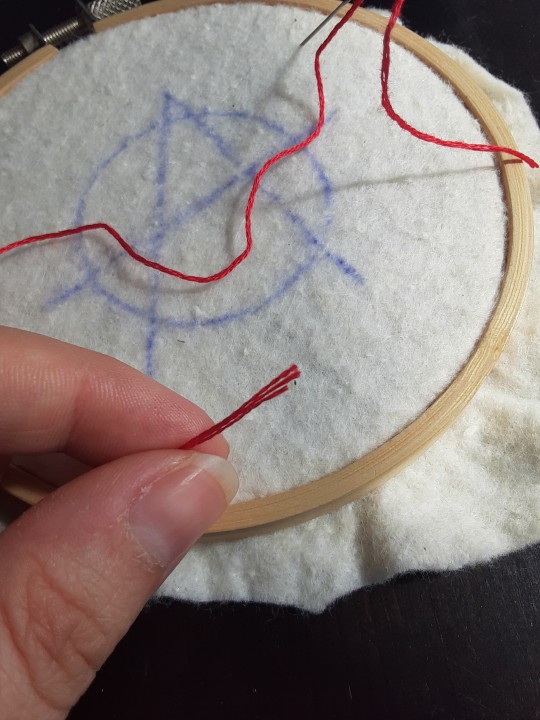
Next, choose your embroidery floss. For my patches I split my embroidery floss into two threads with 3 strands each, as pictured. You can use as many strands in your thread as you prefer, but for the main body of my patches I prefer 3 strands.
Next you're going to start filling your design using a back stitch.

First, put in a single stitch where you want your row to start.

Poke your needle up through the fabric 1 stitch-length away from your first stitch.

Poke your needle back down the same hole your last stitch went into so they line up end-to-end.
Repeat until you have a row of your desired length (usually the length of that colour section from one end to the other). Once you have your first row, you're going to do your next row slightly offset from your first row so that your stitches lay together in a brick pattern like this:
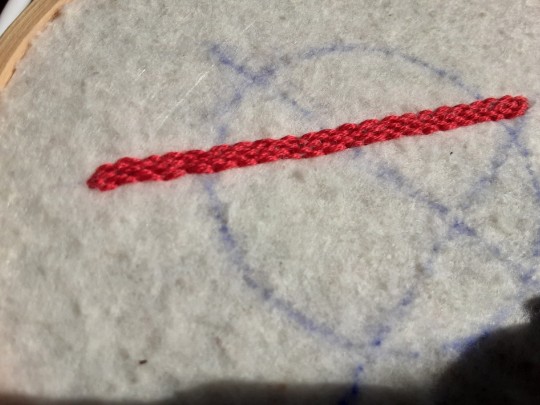
Make sure your rows of stitches are tight together, or you'll get gaps where the fabric shows through.
Rinse and repeat with rows of back stitch to fill in your patch design.
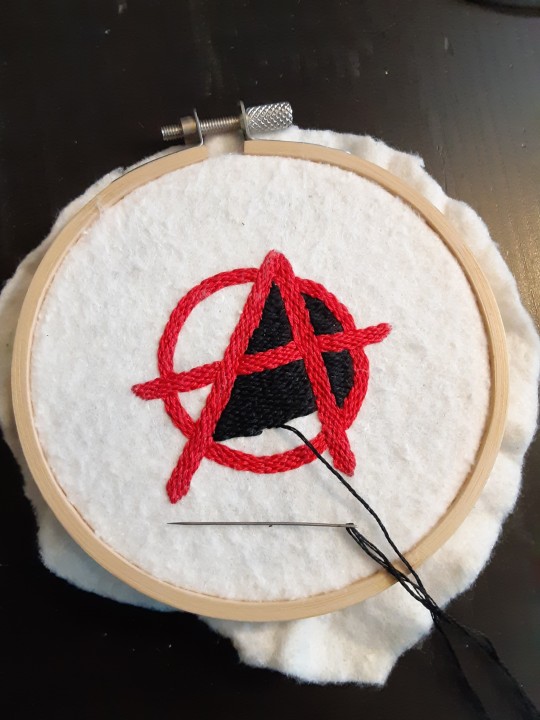
When you're almost to the end of your thread, poke your needle through to the back of the fabric and pull the thread under the back part of the stitching to tuck in the end. Don't worry if it looks messy - no one's gonna see the back anyway.
This next step is fully optional, but I think it makes the patch design really pop. Once your patch is filled in, you can use black embroidery floss to outline your design (or whatever colour you want to outline with - it's your patch, do what you want). I use the full thread (6 strands, not split) of embroidery floss to make a thicker outline.
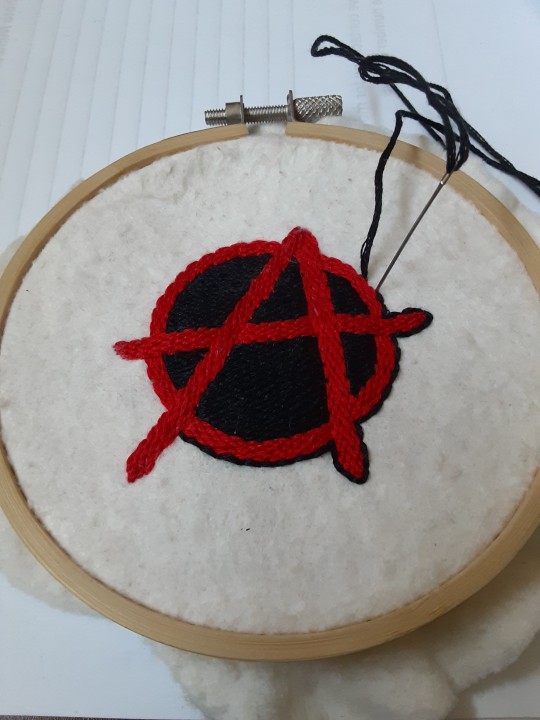
I use the same back stitch I used to fill the piece to make an outline that adds some separation and detail. You could use most any 'outlining' stitch for this, but I just use back stitch because it's just easier for me to do.
Once you're finished embroidering your patch, it's time to cut it out!
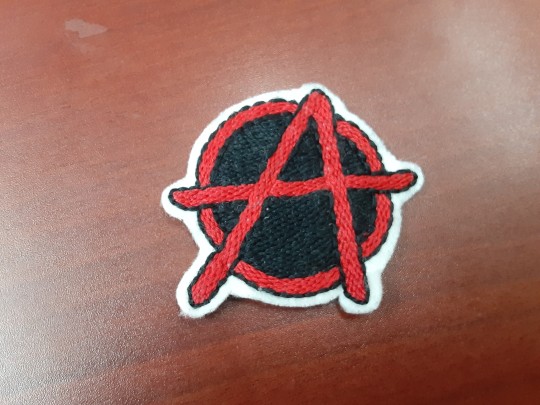
Make sure to leave a little border around the edge to use for sewing your patch on your jacket/bag/blanket/whatever, and be careful not to accidentally cut through the stitches on the back of the patch.
If you have a sturdy enough fabric that isn't going to fray, you can just leave it like this. If not, I recommend using a whip stitch/satin stitch to seal in the exposed edges (I find that splitting your embroidery floss into 3-strand threads works best for this).
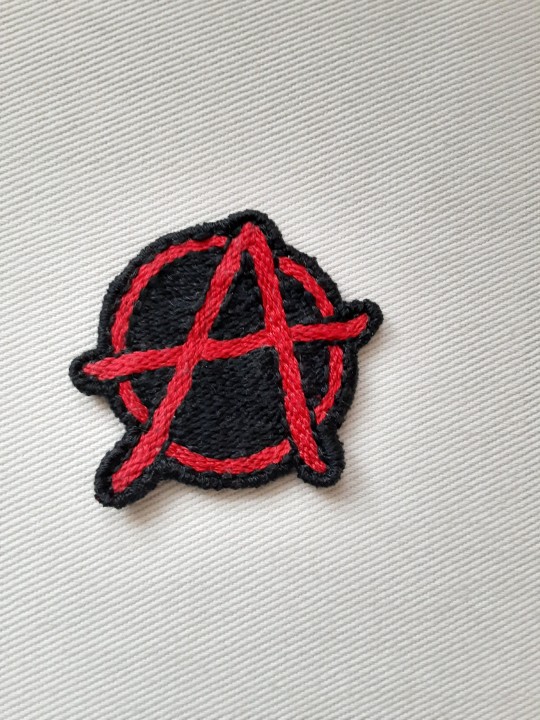
And then you're done! At this point you can put on iron-on backing if you want, or just sew it on whatever you wanna put it on. Making patches this way does take a long time, but I feel that the results are worth it.
Thanks for reading this tutorial! I hope it was helpful. If anyone makes patches using this method, I'd love to see them! 😁
#solarpunk#hopepunk#anti capitalism#sewing#sew on patch#diy punk#handmade#handcrafted#how to#so cool#art#self reliance#anti consumerism#anti conservative#anti consumption#Make your own things and don't rely on a company!
17K notes
·
View notes
Text
I really want to talk about how important it is for us as a people to start making proper city design a priority. I also want to talk about how the privatization of land is the first major barrier to having proper city design.
A lot of seemingly complex issues and tasks can be simplified or made easier to deal with by organizing our cities: Food distribution, commute times, housing, neighborhood safety, public transportation, business/practice regulation, emergency preparedness, general accessibility, mental health, access to medical services, public health, and probably a ton of other things I can't think of right now.
All of that and more could be made much easier if we organized our cities with things like mixed-use-development, the standardization of public transport over personal vehicles, a grid structure, prioritizing walkability on surfaces safe for the disabled (sidewalks over cobblestone), designating districts for certain kinds of services, mandating better minimum (and maximum) size requirements for homes, requiring a certain percentage of greenery or some form of nature for every square footage, and other tactics that I'm probably not even aware of since I'm no city planner.
All of this gets shit on when land can be privately owned, though. Businesses, rich folks, the greedy, and the ignorant buy land without any planning in mind for their community which leads to disorganized, unoptimized, and community-unfriendly cities/towns. Our efforts should always generally lead to the betterment of our community over the selfish betterment of our private circumstances.
#don't forget to unionize your workplace#union#worker rights#r/196#196#power of the people#progress#workers#workers rights#city design#city life#city/town#organization#solarpunk#socialism#communism#communist#tumblr#punk#bright future#hope#eat the rich#anti privatization#landlords#do a crime to the rich#make the abusers of power fear for their lives#crime bois#lqbtq community#disabled community#activism
279 notes
·
View notes
